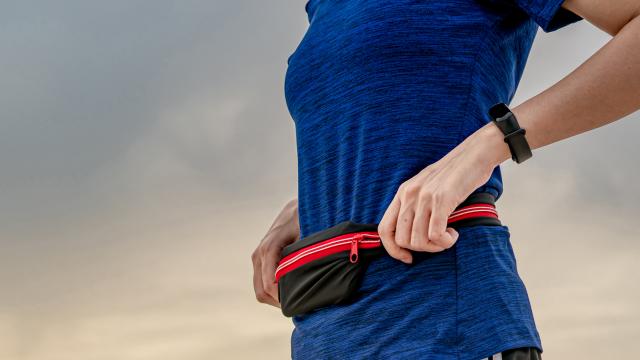Lace up your shoes and go. That’s the simplicity of running. But who leaves their house with just a pair of shoes? Not many runners (I hope). Here’s a full guide to things runners frequently carry, when they carry them, and what they carry them in—from just keys and money for short runs, to survival supplies for long outings on trails.
For a short run: just the basics
On a short run in your neighborhood, there’s not much to prepare for. The essentials are the same as for any time you leave your house: keys, phone, wallet. Many runners will leave their phone at home (especially if they can play music through a running watch), and not everybody bothers with the wallet. But if you’d like to carry these things, here’s how to do it:
What you may want to carry
- Keys (secured in a pocket, bra strap, or one of the belts we mention below)
- Phone (ditto)
- Money, in case you need to buy something while you’re out: either carry a credit card in a small wallet like this one or set up your phone or watch to make contactless payments.
- Your ID (stick it in that mini wallet) or set up your emergency contact info in your phone.
Whether you’ll need water on a short run is up to your preferences and the weather. I’ll include recommendations for carrying water in the section below about long runs.
What to carry it in
Most of the time, I just stuff my phone and keys into my pockets. I make a point of buying shorts and leggings with pockets for exactly this reason. I also have a pair of Flipbelt leggings that the company sent me to try, and the amount of storage space they provide is unbelievable.
But if you’d like an add-on option, check out my review of the minimalist SPIbelt and maximalist FlipBelt. Both are great, honestly. The Koala Clip is a belt-free option that many runners love: it’s a pocket that clips to your waistband (or to anywhere else you’d like to put it, like the back of your sports bra). Choose your fave:
- SPIbelt, $US24.99
- FlipBelt, $US34.00
- Koala clip, $US32.99
For a long run: water and snacks
Once your runs get longer than an hour or so, you have extra needs. If you’re running 90 minutes or more, sports nutritionists strongly recommend fueling with carbs along the way. You’ll also want to carry water, unless you know that there will be plenty of water fountains en route.
Besides food and drink, you’ll have to consider what your skin goes through. Even the most sweat-resistant sunscreen needs to be reapplied every 40 or 80 minutes. And it’s not uncommon to get chafing where body parts rub together or rub against clothing. Smart runners bring an anti-chafing balm or stick for their thighs, armpits, or anywhere else it might be needed (like under your bra band if you wear a bra, or on your nipples if you don’t). Like sunscreen, you can apply this stuff before a run, but you may also want to bring a small stash to reapply as needed.
What you may want to carry
- Gels (or other snacks) to eat every couple miles.
- Water, with the amount depending on the weather and your ability to refill on the go.
- Electrolyte drinks or sports drinks.
- Anti-chafing stick or balm. This tiny tin of Squirrel’s Nut Butter is $US8.99, but the convenience is priceless.
- Extra sunscreen. If you have room in your pack for a mini bottle, great—otherwise, consider carrying single-use packets ($US9.99 for 20).
What to carry it in
There are tons of options for how to carry all your gear, especially the water.
- A handheld bottle is the minimalist option; the strap saves your grip, and you can put your gels and other gear in a pocket or belt like you would for a short run. The Nathan SpeedDraw Plus is an 18-ounce insulated bottle with its own little pocket for $US31.99.
- A hydration belt is the next step up: it’s a belt with pockets, but it can also carry several small water bottles. You can even carry water in one bottle and a sports drink in another. Try this Nike double pocket flask belt for $US43.95.
- Hydration vests are probably the most popular way to carry water and other gear. There’s a bladder in the back, which you can drink from with a straw; and the pockets on the straps allow quick access to gels and to your phone. Try this INOXTO vest for $US26.99, or upgrade to the Nathan TrailMix ($US90.92) for more storage space and expanded sizing.
For emergencies: Be prepared
If you run trails, you may want to carry even more stuff than the basics above. It’s easy to get lost, to stay out later than you intended, or to encounter bad weather or other minor emergencies. Bringing your phone is a must, and consider these as well:
- First aid kit: try this mini one for $US9.99.
- Toilet paper, and a baggie to put used toilet paper into. You can save a partial roll from home and flatten it to fit in your bag, or use these compressed, biodegradable wipes ($US11.97 for 50) that unfold with a drop of water.
- A flashlight of some sort is a must. The traditional handheld kind is fine, but consider a headlamp like this headband style for $US14.99.
- A light drizzle can be refreshing, but if you get soaked and find yourself in chilly weather, you’ll want something to help you stay warm. Pack an emergency poncho ($US13.36 for 10) and/or a mylar space blanket ($US6.99 for 4). The first aid kit above comes with a space blanket, by the way.

Leave a Reply
You must be logged in to post a comment.